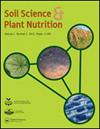“根际物质动力学的最新发展”专节序言
IF 1.8
4区 农林科学
Q3 ENVIRONMENTAL SCIENCES
引用次数: 0
摘要
根际,由Lorenz Hiltner博士于1904年定义,被认为是受植物根系影响的土壤区域。根际作为植物与土壤的界面,与养分动态密切相关。植物根系不仅具有吸收水分和矿质养分的功能,而且还具有释放多种对土壤养分有效性有强烈影响的物质的功能。根分泌的化合物对植物与微生物的相互作用和共生具有重要作用,如根瘤和菌根。尽管“根际”一词多年前就被确立为重要概念,但许多困难,特别是与空间和时间限制有关的困难,阻碍了阐明根际现象的方法。然而,包括宏基因组学、转录组学和代谢组学在内的组学分析方法的最新进展支持了根际研究的突破。事实上,2020年以“根际”为关键词的出版物数量是2000年的6.2倍。最近的方法发展,如使用两种或多种组学方法的多组学分析、表面分析和单细胞分析,在阐明根际现象方面取得了巨大进展。第一次以根际为主题的国际会议于2004年在德国慕尼黑举行。自第一次会议以来,根际会议每3-4年举行一次,出席人数越来越多。2019年在加拿大萨斯卡通举行的会议上,许多涉及根际研究的广泛领域的研究人员发表了重要演讲。包括土壤和植物方面在内的相关领域之间的相互联系再次强调了领域对进一步理解的重要性。日本土壤科学与植物营养学会也扩大了对根际作为一个重要课题的认识。《土壤科学与植物营养》(SSPN)于2018年编辑了“根际磷研究前沿:有效利用土壤中不可用磷(Rhizo-P)”专题。本专题“根际物质动态的最新发展”介绍了该领域的最新研究进展。白露平,这是众所周知的集群根形成植物物种显示渗出爆发,是在文章中讨论矿物动员的主题。在一篇文章中,植物激素参与了根的独特形态。这期还介绍了植物对营养缺乏和逆境环境反应的新发现。涉及植物与微生物之间的共生和竞争以及相关物质的主题也很重要。还讨论了矿物质营养的空间动态。该部分的研究论文由客座编辑委员会(Wasaki Jun博士[主任]、Takuro Shinano博士、Naoko Ohkama-Ohtsu博士、Junpei Takano博士和Kyoko Miwa博士)通过公告收集。许多手稿已经从广泛的根际研究人员,包括与会的根际会议贡献。他们完全采用与发表在SSPN上的其他论文相同的过程进行同行评议。我真诚地希望这些论文包括来自研究挑战前沿的报告,以推进重要课题的工作,并有助于未来对根际物质动力学的进一步了解。最后但并非最不重要的是,我感谢所有审稿人的宝贵意见,感谢SSPN编辑委员会给我们出版这一专题的机会。本文章由计算机程序翻译,如有差异,请以英文原文为准。
Preface to the special section 'Recent developments on dynamics of substances in the rhizosphere'
The rhizosphere, as defined by Dr. Lorenz Hiltner in 1904, is recognized as the region of soil influenced by plant roots. As the interface of a plant and soil, the rhizosphere is tightly involved in nutrient dynamics. Plant roots have functions not only to uptake water and mineral nutrients but also to release a wide diversity of substances that have strong effects on nutrient availability in soils. Root-secreted compounds have important roles affecting plant–microbial interactions and symbioses, such as nodules and mycorrhiza. Although the term ‘rhizosphere’ was established as important many years ago, many difficulties particularly related to spatial and temporal constraints have hindered approaches to clarify phenomena found in the rhizosphere. Nevertheless, recent progress of analytical methods including omics analyses such as metagenomics, transcriptomics, and metabolomics have supported breakthroughs in rhizosphere research. In fact, publications including ‘rhizosphere’ as a keyword were 6.2 times more numerous in 2020 than in 2000. Recent developments of methodologies such as multiomics analyses using two or more methods of omics approaches, surface analysis, and single-cell analysis have supported great strides in elucidating rhizosphere phenomena. The first international conference on the topic of rhizospheres was held in 2004 in Munich, Germany. The rhizosphere conference has been held every 3–4 years since that first conference, with increasing attendance. Many researchers in broad fields involved in the study of rhizospheres have made important presentations at the recent conference in 2019 at Saskatoon, Canada. Interconnections among related fields including both soil and plant sides have re-emphasized the fields’ importance for further understanding. Recognition of the rhizosphere as an important topic has also been extended by the Japanese Society of Soil Science and Plant Nutrition. Soil Science and Plant Nutrition (SSPN) edited a special section ‘Frontline in the Rhizosphere Research Involved in Phosphorus: for Efficient Use of Unavailable P in Soils (Rhizo-P)’ in 2018. This Special Section, ‘Recent developments on dynamics of substances in the rhizosphere’, has been proposed to introduce current research progress in the fields. White lupin, which is well known as a cluster root forming plant species showing exudative bursts, is addressed in articles on the mineral mobilization topics. Involvement of phytohormones in the unique morphology of roots has been newly suggested in an article. Novel findings related to plant responses to nutrient deficiency and stress environments are also presented in this issue. Topics involved in the symbioses and competition between plants and microbes, and the related substances are also important. The spatial dynamics of mineral nutrients are also addressed. Research papers presented in the section were collected through announcements by the Guest Editorial Board (Dr. Jun Wasaki [chief], Dr. Takuro Shinano, Dr. Naoko Ohkama-Ohtsu, Dr. Junpei Takano, and Dr. Kyoko Miwa). Many manuscripts have been contributed from a wide range of rhizosphere researchers including attendees of the rhizosphere conference. They were peer reviewed entirely using the same processes as other papers published in SSPN. It is my sincere hope that the papers include reports from the front line of research challenges for the advancement of work on important topics and that they contribute to further progress in understanding of the dynamics of substances in the rhizosphere in the future. Last but not least, I thank all the reviewers for their valuable comments and the SSPN Editorial Board for giving us the opportunity to publish this Special Section.
求助全文
通过发布文献求助,成功后即可免费获取论文全文。
去求助
来源期刊

Soil Science and Plant Nutrition
农林科学-农艺学
CiteScore
4.80
自引率
15.00%
发文量
56
审稿时长
18-36 weeks
期刊介绍:
Soil Science and Plant Nutrition is the official English journal of the Japanese Society of Soil Science and Plant Nutrition (JSSSPN), and publishes original research and reviews in soil physics, chemistry and mineralogy; soil biology; plant nutrition; soil genesis, classification and survey; soil fertility; fertilizers and soil amendments; environment; socio cultural soil science. The Journal publishes full length papers, short papers, and reviews.
 求助内容:
求助内容: 应助结果提醒方式:
应助结果提醒方式:


